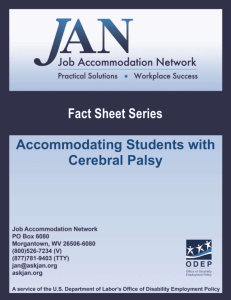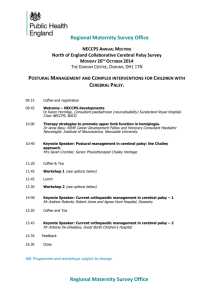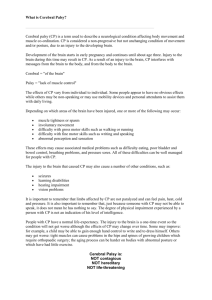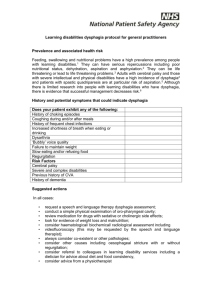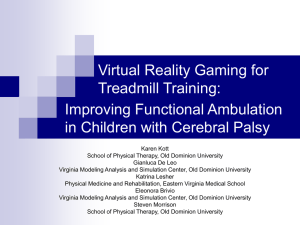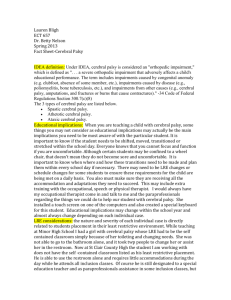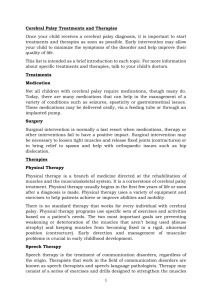Supporting children and young people with cerebral
advertisement
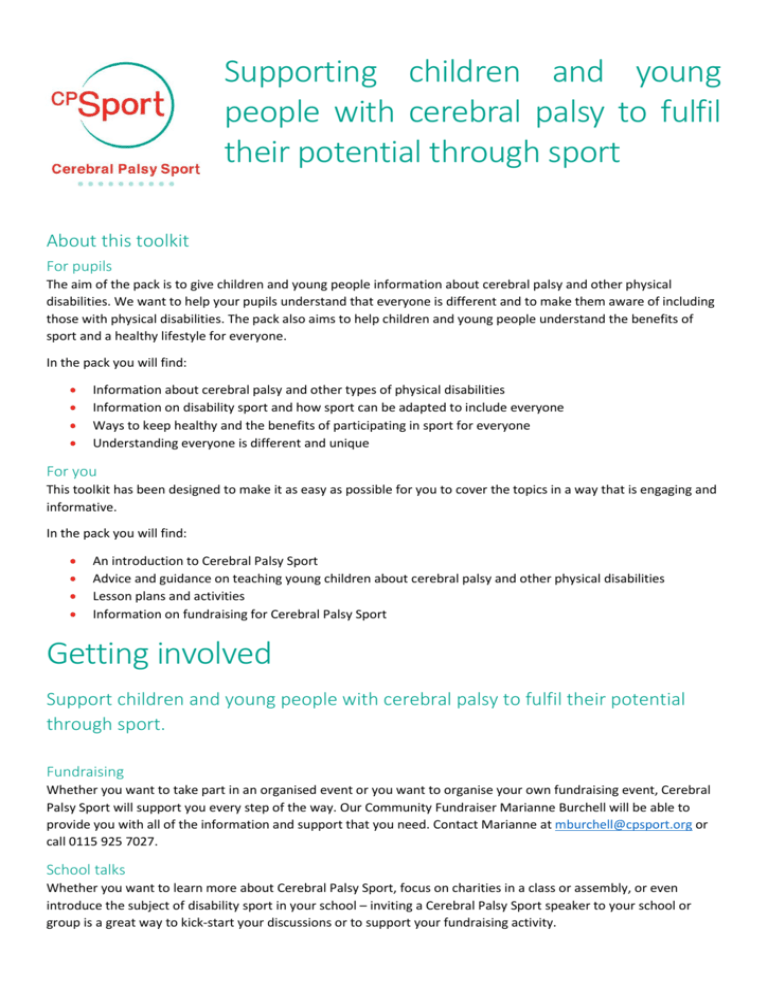
Supporting children and young people with cerebral palsy to fulfil their potential through sport About this toolkit For pupils The aim of the pack is to give children and young people information about cerebral palsy and other physical disabilities. We want to help your pupils understand that everyone is different and to make them aware of including those with physical disabilities. The pack also aims to help children and young people understand the benefits of sport and a healthy lifestyle for everyone. In the pack you will find: Information about cerebral palsy and other types of physical disabilities Information on disability sport and how sport can be adapted to include everyone Ways to keep healthy and the benefits of participating in sport for everyone Understanding everyone is different and unique For you This toolkit has been designed to make it as easy as possible for you to cover the topics in a way that is engaging and informative. In the pack you will find: An introduction to Cerebral Palsy Sport Advice and guidance on teaching young children about cerebral palsy and other physical disabilities Lesson plans and activities Information on fundraising for Cerebral Palsy Sport Getting involved Support children and young people with cerebral palsy to fulfil their potential through sport. Fundraising Whether you want to take part in an organised event or you want to organise your own fundraising event, Cerebral Palsy Sport will support you every step of the way. Our Community Fundraiser Marianne Burchell will be able to provide you with all of the information and support that you need. Contact Marianne at mburchell@cpsport.org or call 0115 925 7027. School talks Whether you want to learn more about Cerebral Palsy Sport, focus on charities in a class or assembly, or even introduce the subject of disability sport in your school – inviting a Cerebral Palsy Sport speaker to your school or group is a great way to kick-start your discussions or to support your fundraising activity. Cerebral Palsy Awareness Month is March and World Cerebral Palsy Day is 7th October. While this pack can be used at any time these two dates are the perfect opportunity to discuss cerebral palsy and other physical disabilities. Look at www.cpsport.org for stories and activities around these dates. About Cerebral Palsy Sport Cerebral Palsy Sport is the country’s leading national disability charity supporting people with cerebral palsy to reach their sporting potential. The charity is dedicated to giving children, young people and adults with cerebral palsy and other physical disabilities opportunities to enjoy the health, wellbeing and social benefits of sport and physical activity. Our Vision: To support people with cerebral palsy to reach their life potential through sport and active recreation. Our Mission: To improve quality of life for people with cerebral palsy and other physical disabilities through sport, physical activity and active recreation. Our Aims and Objectives: To raise aspirations, promote inclusion and support people with cerebral palsy and other disabilities to play, participate and enjoy sport and active recreation. We achieve this through providing disability and adapted sports, such as football, swimming, athletics, bowls, table cricket and new age kurling. We also offer expert, specialist support to parents, support workers, teachers, coaches, physiotherapists, occupational therapists, sport providers and other professionals on how to adapt sports so more people with physical disabilities can enjoy them. Based in Nottingham, Cerebral Palsy Sport is a small charity however through delivering activities across the country we have national reach and impact. Annually we support over 2,000 people, including more than 600 young people with mild, moderate and severe disabilities – promoting the inclusion of people with a disability through sport and physical activity. What is Cerebral Palsy? What is Cerebral Palsy? Cerebral palsy is a condition that affects muscle control and movement. It is usually caused by an injury to the brain before, during or after birth. Children with cerebral palsy have difficulties in controlling muscles and movements as they grow and develop. Is there a cure for cerebral palsy? There is no cure for cerebral palsy, but physiotherapy and other therapies can often help people with cerebral palsy become more independent. No two people will be affected by their cerebral palsy in the same way. How common is cerebral palsy? In the UK, cerebral palsy affects about one in every 400 children. Cerebral palsy can affect people from all social backgrounds and ethnic groups. What causes cerebral palsy? There may be no obvious single reason why a child has cerebral palsy. The main causes of cerebral palsy include: Infection in the early stages of pregnancy Lack of oxygen to the brain Abnormal brain development Types of cerebral palsy There are three main types of cerebral palsy. Many people will have a mixture of these types. Spastic cerebral palsy Is present in around 75-88% of people with cerebral palsy. Spasticity means the muscle tone is tight and stiff causing a decreased range of movement. As the muscle tone is so tight, spasticity can be very painful with muscles often going into spasm. It can affect many different areas of the body. Dyskinetic cerebral palsy Sometimes referred to a dystonic, athetoid or choreoathetoid cerebral palsy, it is present in about 15% of people with cerebral palsy. Dyskinetic cerebral palsy causes uncontrolled, involuntary, sustained or intermittent muscle contractions as the muscle changes from tight to loose. The whole body can be affected which can make it difficult to maintain an upright position. Speech can also be affected as the person may experience difficulty controlling the tongue, vocal chords and breathing. Ataxic cerebral palsy Ataxia is an inability to activate the correct pattern of muscles during movement. Balance is affected and the person may have poor spatial awareness or find it difficult to judge their body position in relation to things around them. It is present in about 4% of people with cerebral palsy and can affect the whole body. Most people with ataxic cerebral palsy can walk but they will be unsteady with shaky movements. Speech and language may also be affected. Mixed cerebral palsy Many people with cerebral palsy will have a combination of the above types. You may also come across terms such as hemiplegia or diplegia. These terms refer to the part of the body affected by the cerebral palsy. For example, hemiplegia means that the person is affected on one side of the body. Diplegia is where two limbs are affected, Monoplegia is where one limb is affected and Quadriplegia is where all four limbs are affected. Cerebral palsy: associated conditions Some people with cerebral palsy may have some associated conditions while others may not. These can include: Learning difficulty – although children with cerebral palsy cover the same range of intelligence as other children. Epilepsy – up to a third of children with cerebral palsy. Communication difficulties Does cerebral palsy change over time? Cerebral palsy itself is not progressive, the injury to the brain does not change. However the effects may change over time for better or worse. (Source www.scope.org.uk) Advice on teaching children and young people about cerebral palsy Children and young people may never have heard about cerebral palsy unless there is someone at the school with the condition. Even if they have heard about other physical disabilities, they may not have a clear understanding of what it means. So, whether they have been directly affected, it is likely they will have their own assumptions about what it is like having a physical disability. Sometimes these can be misinformed and talking about disabilities with your class is a good away to address any fears and misconceptions about living with a physical disability. Key points for young people It is understandable that children and young people are not sure of what is it like to have a physical disability or understand why some people have various disabilities and can even be scared of people who are different to them. It is a complex topic with lots to discuss. These are some of the key points that it would be good for your pupils to understand. You can’t catch a disability from anyone Not everyone with a disability is the same Even someone severely physically affected by cerebral palsy may have average or above average intelligence Creating a comfortable environment Talking about physical disabilities needs to be done with sensitivity. It is crucial to create a comfortable environment so that your pupils feel happy to speak. It is also a good idea to set out or recap ground rules for the discussion at the start of each session. These might include: Respect other people’s contributions Be aware of other people’s feelings. Anything spoken about in the group is meant for the group only. It is not to be shared with others. Make sure pupils know where they can go if they need to talk to an adult or ask questions about anything that comes up in class. If someone in your class is affected by cerebral palsy or another physical disability Talking about physical disabilities such as cerebral palsy with children and young people is something which needs to be handled sensitively. It is crucial to make sure you understand the needs and wishes of any pupils or adults in your class who are affected by a physical disability. Talk to them about the topics you’re going to discuss, ask for their input and give them the option of opting out if they are uncomfortable. Lesson plans Lesson 1: What is a disability? Breaking the ice Start the lesson by setting the ground rules for class discussions. Introduce the topic. Explain to your class that cerebral palsy is a physical disability and affects one in 400 people. Explain that there are many misconceptions about people that have a disability and that talking about them means they will understand more about how we are all different. Talking points Discuss with your pupils about what they know, or think about people that have a physical disability and any questions that they have. It’s a good thing to include any misconceptions at this stage – you can then refer back to these and correct them later. Get the class to read through the activity sheet 1. What is a physical disability? This is a great way to help you explain what cerebral palsy is. This lesson will help pupils understand: The basic facts about cerebral palsy Common misconceptions about people with a physical disability For this lesson you will need Activity sheet 1. What is a physical disability? Activity sheet 2. Have I got the facts? Scissors Glue Go through the ‘Have I got the facts?’ questions on the activity sheet to help dispel common myths about cerebral palsy and other physical disabilities. Class activity To reinforce their learning, hand out Activity Sheet 2. Have you got the facts? In small groups or pairs, ask the pupils to answer the five true or false questions and write their reason for choosing each answer. As a class go through the answers and ask the pupils to explain why they chose each answer. The correct answers: 1) A person with a disability cannot go out of the house on their own? FALSE Some people who have physical disabilities need a carer but many people lead independent lives. 2) A person with a physical disability can be a professional sports person? TRUE All of the athletes at the Paralympic Games have a disability. Many of them are professional athletes and train for several hours a day to try to win Paralympic medals. 3) A person with a physical disability is not as clever as someone without a physical disability? FALSE People with physical disabilities are just as clever as the rest of us. With some being very clever and others needing more support. 4) A person only has a disability if you can see it? FALSE You cannot always see if someone has a disability. For example, they might have a hearing or visual impairment or even a physical disability. Some people may have Cerebral Palsy and you can hardly even notice by looking at them. 5) A person with a disability can have a successful job? TRUE People with disabilities can lead healthy, happy and independent lives which can include having successful job. Checking understanding To finish the session, ask pupils to recall some key facts they have learnt about people with physical disabilities. This is a good time to refer back to pupils’ initial ideas about people with cerebral palsy to correct any remaining misconceptions or to answer any questions they may have. Let pupils know where they can go with any concerns or questions about any issues raised in the lesson. Activity Sheet 1. What is a disability? What is a disability? There are a number of different types of disability. Visual Impairment Physical Disability Hearing impairment Autism Learning Disability Cerebral Palsy is a type of physical disability That affects muscle control and movement. People usually have it from birth. Cerebral Palsy affects everyone differently. Activity Sheet 2. Have you got the facts? Circle what you think is the correct answer to the question 1) A person with a disability cannot go out of the house on their own? True False Why did you choose your answer? _________________________________________________________________ _________________________________________________________________ 2) A person with a physical disability can be a professional sports person? True False Why did you choose your answer? _________________________________________________________________ _________________________________________________________________ 3. A person with a physical disability is not as clever as someone without a physical disability? True False Why did you choose your answer? _________________________________________________________________ _________________________________________________________________ 4) A person only has a disability if you can see it? True False Why did you choose your answer? ________________________________________________________________ ________________________________________________________________ 5) A person with a disability can have a successful job? True False Why did you choose your answer? _________________________________________________________________ _________________________________________________________________ Lesson 2: Eat well and get active Breaking the ice Start the lesson by setting the ground rules for class discussions. Introduce the topic. Start by holding a class discussion about all the things that make up a healthy lifestyle. Ask your pupils to suggest why looking after their bodies and keeping fit and healthy is important. Go on to explore the idea that our health affects most areas of our lives, including how we feel on the inside. Explain that looking after yourself when you’re young helps you get into healthy patterns for the rest of your life. This lesson will help pupils understand: For this lesson you will need Talking points The main focus of the lesson is to explain to the class that a healthy lifestyle and getting sporty has lots of benefits for everyone. The benefits of eating healthily The importance of exercise for good health Different ways to keep healthy Materials to make posters or leaflets Examples of informative posters or leaflets Ask your pupils what things people can do to keep themselves healthy. These are: Eat a healthy, balanced diet Eat at least five portions of fruit and vegetables every day Avoid fatty and processed foods Limit how much sugar they eat Get active Try to do at least one hour of exercise a day. (NHS, March 2012) Walk or cycle to and from school if possible Try to have variety in their activity to keep interested, such as going to the park once a week, playing hide and seek and helping to wash the car Join school clubs to try out different sports Class activity Ask your pupils to choose from the two areas to create a poster or leaflet. It needs to highlight to other young people the importance of eating well and getting active. They can even draw themselves if they enjoy taking part in a regular sporting activity. If possible show them examples of informative posters and leaflets and look at their features and what makes them good. Checking understanding Recap what makes a great poster or leaflet and ask pupils to assess each other’s work. Is the message clear and persuasive? A good idea could be to put the best poster or leaflet up for display. Extension Ask pupils to keep an exercise diary for a week. They can add up the number of minutes exercise at the end of the week to see if they’re getting the recommended amount. (Visit www.nhs.uk/livewell for the latest guidelines) Lesson 3: Inclusive Sports Day Breaking the ice Start the lesson by setting the ground rules for class. Introduce the topic. Start by holding a class discussion about the benefits of a healthy lifestyle for everyone. Go on to explore the idea that our health affects most areas of our lives, including how we feel on the inside. Explain that sport can be adapted to include everyone, regardless of their ability. Main talking point Ask if any of the class have seen any disability sport? Explain that the Paralympics are where people with a disability compete in a number of different sports. This lesson will help pupils understand: Some of the challenges people with physical disabilities face About different disability sports. For this lesson you will need Sports hall/outside space Sports equipment such as balls, bean bags and Boccia balls Class activity Using the Paralympics as inspiration, ask pupils for ideas about different sports that can be played by the whole class and how they demonstrate some of the challenges people with physical disabilities such as cerebral palsy face. Options are: Get the pupils to throw a beanbag/indoor javelin and then to throw it again but this time from a seated position to see the difference that it makes. The world record for the Paralympic sport of Club throw is 36.31 metres! Many people with cerebral palsy have tight calf muscles and walk on their tip-toes to demonstrate how challenging and tiring this is, get the children to play a running game such as tag while on their tiptoes. All pupils put one hand behind their backs and try to throw and catch a ball back and forth. Discuss how it also affects you balance only using one hand. Hold a penalty shoot-out but pupils can only kick with their other foot to demonstrate coordination difficulties that can be associated with cerebral palsy. Get all of the pupils to sit on chairs to play Boccia. Explain how this is an example of everyone playing a sport from the same position and that Boccia is a specialist sport for people with a disability and is a Paralympic sport. Checking understanding Recap what the benefits are of a healthy lifestyle are. Explain that everyone should enjoy an active lifestyle and that people with any form of disability should focus on their ability not their disability. All sports can be adapted so that people of all levels can join in. Lesson 4: We are all different Breaking the ice Start the lesson by setting the ground rules for class discussions. Introduce the topic. Begin by explaining to pupils that having cerebral palsy can have a big impact on people’s lives – not only because of the physical impact on them but also on their confidence because they feel different. Talking points This lesson will help pupils understand: Ask the pupils if they can describe what the word ‘different’ means? The main focus of the lesson is to discuss things which make us unique. These can include: To identify what is unique about ourselves as individuals That everyone is different and that we are all special in our own way For this lesson you will need Materials to draw pictures Activity sheet 3 Having a pet snake Having a unique hobby Playing an interesting instrument Speak a different language at home Class activity Invite the children to think about one aspect of their life outside school which they think is different or unique. Can they draw a picture of themselves taking part in this special activity and then talk to the class about it? Encourage the children to ask questions to find out more information. Checking understanding Recap on why it is important that people are different and do different things. Explain that people that have physical disabilities need organisations like Cerebral Palsy Sport. Extension What might be a consequence if no one was different? Can the pupils imagine what their lives would be like it everyone was only interested in the same things? Activity Sheet 3. We are all different Draw a picture of something that makes you unique in the picture fame below.

